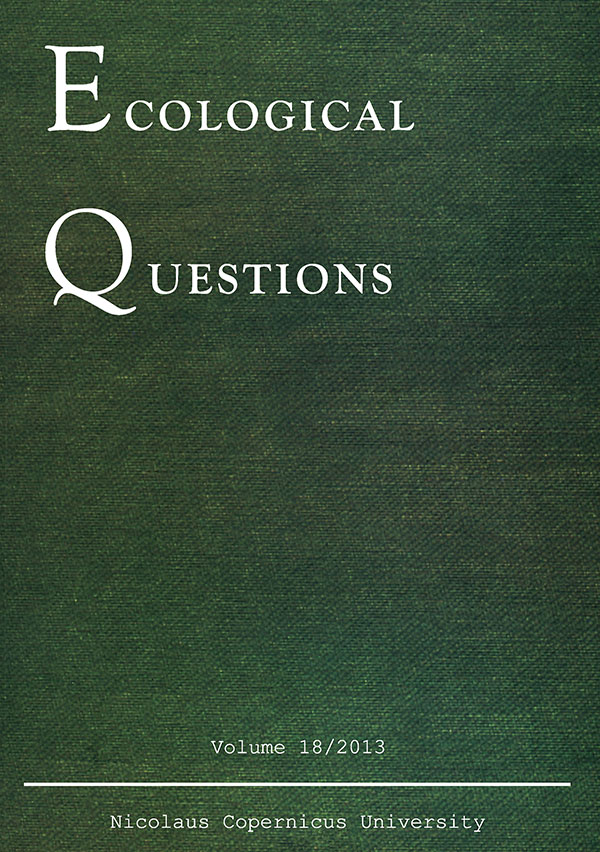Long term monitoring of the vegetation in the salt marsh of “Psili Amnos”, Samos, Greece – the outlines of the monitoring project
DOI:
https://doi.org/10.12775/ecoq-2013-0011Keywords
saline area, halophytes, monitoring methodology, classification, ordinationAbstract
This short note presents research project on SAMOS: PARALIA ALYKI in Greece. The area of the research includes salt marsh of about 500 m2 which is located in the Natura 2000 protected area of the site code GR4120001. There are 150 protected birds including 57 birds in the red list of IUCN. Vegetation is quite heterogeneous and distinct in different sections. The aim of the project is to develop and implement a long term monitoring scheme for the salt marsh of “Psili Amnos” to assess changes of the vegetation over time and to assess anthropogenic and natural threat in order to take conservation measures. In a note in addition to the presentation of the site and the research aim also the methods considered for monitoring of vegetation are briefly described. To achieve optimal and universal methodology there was discussed which of the methods of data collection and processing typically used in monitoring vegetation could be used both in a project implemented at salt marsh “Psili AMNOS” as well as in studies of coastal and inland salt marshes in Poland.References
Bosiacka B., 2012, 1330 Solniska nadmorskie (Glauco- -Puccinietalia – część zbiorowiska nadmorskie) [Coastal salt marshes (Glauco-Puccinellietalia – part coastal communities)], [in:] W. Mróz (ed.), Monitoring Siedlisk Przyrodniczych, Przewodnik Metodyczny, Część druga [Monitoring Habitats Methodological Guide, Part Two], Biblioteka Monitoringu Środowiska, Inspekcja Ochrony Środowiska, Warszawa: 72-84.
Braun-Blanquet J., 1964, Pflanzensoziologie, 3-rd edition, Aufl., Springer, Wien.
Hulisz P., Elvisto T., Karasiewicz M.T., Piernik A., 2011, Abiotic factors influencing the occurrence of Salicornia europaea in West Estonia, Ecological Questions 14: 57-60. DOI: 10.2478/v10090-011-0017-4
Herbich J., 2004, 1330 Solniska nadmorskie (Glauco-Puccinellietalia, część – zbiorowiska nadmorskie) [Coastal salt marshes (Glauco-Puccinellietalia – part coastal communities)], [in:] J. Herbich (ed.), Siedliska morskie i przybrzeżne, nadmorskie i śródlądowe solniska i wydmy, Poradniki ochrony siedlisk i gatunków Natura 2000 – podręcznik metodyczny Tom 1 [Marine and coastal habitats, coastal and inland salt flats and sand dunes, Tutorials protection of habitats and species Natura 2000 sites – Methodological Manual Volume 1], Ministerstwo Środowiska, Warszawa: 86-96.
Hill M. O. & Šmilauer P., 2005, Twinspan for Windows 2.3, Centre for Ecology and Hydrology & University of South Bohemia, Hutington & Česke Budějovice.
Jongman R. H. G., ter Braak C. J. F., & van Tongeren D. F. R. (eds.), 1995, Data analysis in community and landscape ecology, Pudoc, Wageningen.
Kovach W. L., 1986-1999, MVSP „PLUS” version 3.1, Pentraeth, UK.
Nienartowicz A. & Piernik A., 2004a, 1310 Śródlądowe błotniste solniska z solirodem (Salicornion ramossissimae) [Inland salt marshes of Glasswort (Salicornion ramossissimae)], [in:] J. Herbich (ed.), Siedliska morskie i przybrzeżne, nadmorskie i śródlądowe solniska i wydmy, Poradniki ochrony siedlisk i gatunków Natura 2000 – podręcznik metodyczny Tom 1 [Marine and coastal habitats, coastal and inland salt flats and sand dunes, Tutorials protection of habitats and species Natura 2000 sites – Methodological Manual Volume 1], Ministerstwo Środowiska, Warszawa: 79-85.
Nienartowicz A., & Piernik A., 2004b, *1340 Śródlądowe słone łąki, pastwiska i szuwary (Glauco-Puccinellietalia, część – zbiorowiska śródlądowe) [Inland salt meadows, pastures and rushes, Glauco-Puccinietalia, part – inland communities], [in:] J. Herbich (ed.), Siedliska morskie i przybrzeżne, nadmorskie i śródlądowe solniska i wydmy, Poradniki ochrony siedlisk i gatunków Natura 2000 – podręcznik metodyczny Tom 1 [Marine and coastal habitats, coastal and inland salt flats and sand dunes, Tutorials protection of habitats and species Natura 2000 sites – Methodological Manual Volume 1], Ministerstwo Środowiska, Warszawa: 97-119.
O’Leary J. W. & Glenn E. P., 1994, Global distribution and potential for halophytes, [in:] V. R. Squiers, A. T. Ayoub (eds), Halophytes as resource for livestock and rehabilitation of degraded lands, Tasks for Vegetation Science 32, Kluwer, Dordrecht: 7-15.
Piernik A., 2010, 1340* Śródlądowe słone łąki, pastwiska i szuwary, Glauco-Puccinietalia, część – zbiorowiska śródlądowe [Inland salt meadows, pastures and rushes, Glauco-Puccinietalia, part – inland communities], [in:] W. Mróz (ed.), Monitoring Siedlisk Przyrodniczych, Przewodnik Metodyczny, Część pierwsza [Monitoring Habitats Methodological Guide, Part One], Biblioteka Monitoringu Środowiska, Inspekcja Ochrony Środowiska, Warszawa: 46-60.
ter Braak C. J. F. & Šmilauer P., 2002, CANOCO Reference manual and CanoDraw for Windows User’s guide: Software for Canonical Community Ordination (version 4.5), Microcomputer Power, Ithaca, NY, USA.
Waisel Y., 1972, Biology of halophytes, Academic Press, New York and London.
Downloads
Published
How to Cite
Issue
Section
Stats
Number of views and downloads: 567
Number of citations: 0



